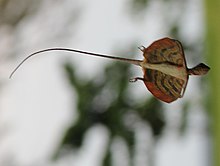Flying skin

As patagium (patagium), whether plane or Gleitmembran a is as wing serving skin (with or without support structures) in vertebrates , respectively.
Flying membranes were developed in all five vertebrate classes , but only in two classes were real membrane fliers capable of active flapping flight : the bats (Chiroptera) in mammals and, in geological history, the pterosaurs (Pterosauria) in reptiles . In other recent and fossil species , the membrane serves the passive sliding or parachute flight to the extended jump from, tree to tree or from the tree to the ground , which is often supported by fluttering movement. These species cannot actively determine the direction, altitude and duration of the flight.
The structures from which flight skins were formed and their location on the body vary depending on the species.
Mammals
In mammals, a distinction is made between three areas of the body in which a flight skin can be formed:
- The neck membrane ( Propatagium ) extends between the neck and the front extremity.
- The arm or flank flight skin ( plagiopatagium ) runs along the side of the body between the front and rear extremities.
- The tail fly skin ( uropatagium ) extends from the tail to the rear extremity.
These sections of the flight membrane are present in mammals as follows:
- Giant glider (Dermoptera): Pro-, Plagio- and Uropatagium
- Flying squirrel (Pteromyinae): Plagiopatagium; Pro- and Uropatagium very small
- Thorntail Squirrel (Anomaluridae): Plagio and Uropatagium
- Gleitbeutler (Petauridae): hairy plagiopatagium
In the bats (Chiroptera) in particular , a fourth body area is added to the Pro-, Plagio- and Uropatagium: a large part of the entire flight membrane is stretched between their greatly elongated metacarpal and finger bones. One speaks here of the Dactylopatagium (" finger flight skin ") or Chiropatagium ("hand flight skin"). In the giant gliders there is also flight skin between the fingers and toes, but in them the chiropatagium only makes up a small proportion of the total flight skin.
In the flying foxes (Megachiroptera) the uropatagium is only a narrow strip of skin on the hind legs because they have no or only a very short tail.
During the evolution of mammals, flying membranes developed at least eight times independently of one another. This is the case with gliding squirrels , gliding bags , dwarf gliding bags , ring bags (Pseudocheiridae), giant gliders , thorn-tailed squirrels , bats and the Cretaceous mammal Volaticotherium .
Birds
In birds, flight skins brace the different parts of the bird's wing together, fill the spaces between the bones and limit the wing core to the front and back. The most important are the anterior flight membrane, the posterior flight membrane and the large marginal ligament between the elbow and metacarpal bones.
The wing area is further enlarged by means of flight springs. The wing feathers are the largest feathers on the wing and are divided into hand wings and arm wings depending on where they are inserted. A band of connective tissue holds them in place. They interlock like roof tiles.
Reptiles
Kites ( Draco ; Agamidae ) are glider and have lateral skin flaps that are stretched with the help of elongated ribs , while the flight skins are folded up during rest. The flattened body also improves the aerodynamic properties, while the tail serves as a rudder. In this way, they can slide up to eight meters, in exceptional cases significantly further.
Bony fish
Flying fish (Exocoetidae) shoot themselves out of the water with short, rapid blows with their tail fin, which is extended in the lower part, and with their large, wing-like spreadable pectoral fins, they usually sail a meter, with favorable updrafts, up to almost 10 meters above the water surface. More than 200 million years ago , the Thoracopteridae, a family of slippery bony fish and the oldest known slippery fish , lived in the Palaeotethys , in the area of today's Mediterranean and the Alps . In the fossil record , the widened pectoral fins and the elongated lower part of the caudal fin can be clearly seen.
Amphibians

A sliding membrane stretches between the fingers and toes of the actual rowing frogs ( Rhacophorus ) from Southeast Asia. This is spread out after the jump and allows you to slide from tree to tree. In this way, the animals can change their habitat or escape predators while saving energy and avoiding the dangerous soil region.
Individual evidence
- ↑ Martin Walters & Jinny Johnson: "Animals of this world. From the ant to the blue whale" PARRAGON Verlag, Bath 2004, ISBN 1-40543-439-2 , p. 195.
- ↑ Georg Rüppel: Vogelflug. Kindler, Munich 1975, ISBN 3-463-00611-1 , p. 38.
- ^ Gerhard Hummel: Anatomy and Physiology of Birds. Ulmer, Stuttgart 2000, ISBN 3-8252-2144-X , pp. 30-33 and 202-203.



